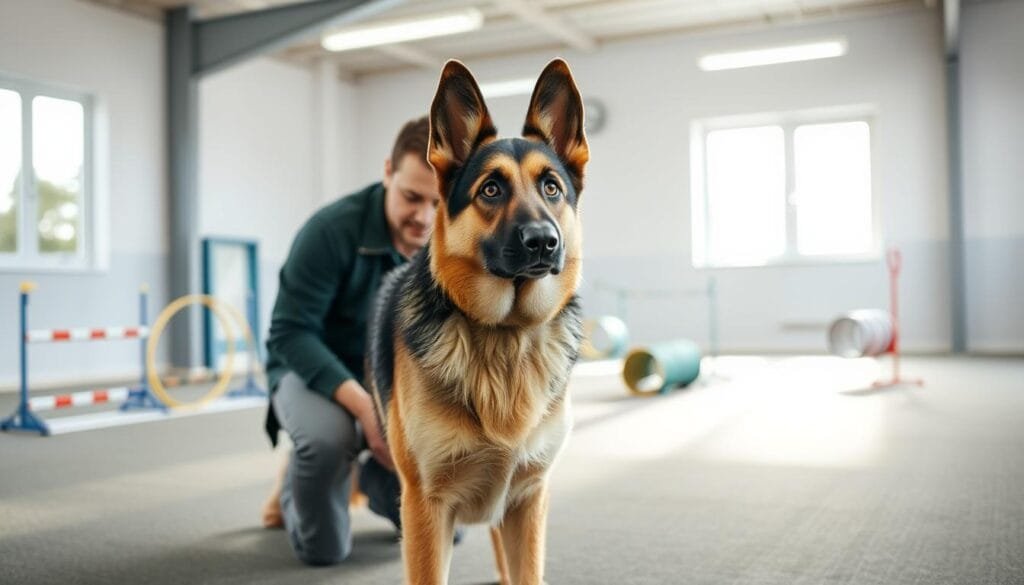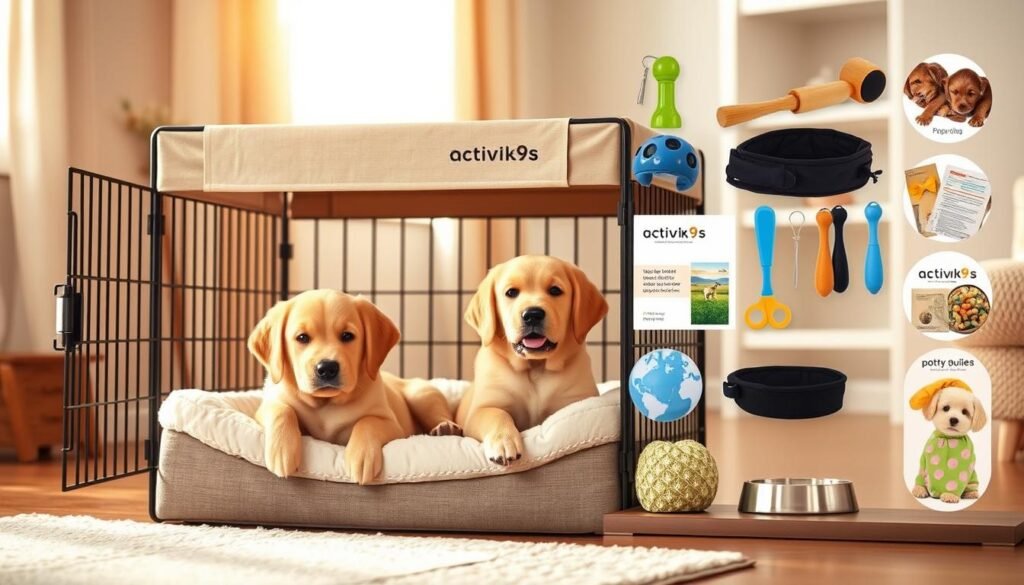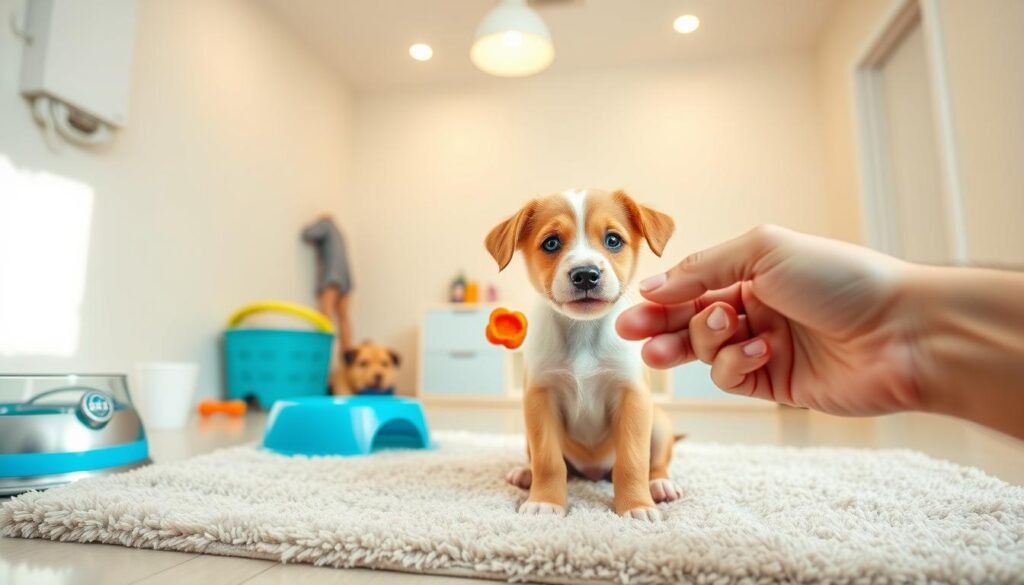Tips to Help a Fearful Dog Feel More Confident
Many dogs experience fear and anxiety in different situations, whether it’s loud noises, unfamiliar environments, or even meeting new people. Helping a fearful dog gain confidence can take time and patience, but with the right strategies in place, you can make a significant impact on their emotional well-being. An effective approach to instilling poise in nervous pooches is to create a safe and comfortable environment where they feel secure. This space can act as a retreat during stressful moments, helping them to develop a sense of stability.
One of the key methods for desensitising fearful fidos is gradual exposure to the stimuli that trigger their anxiety. Start by introducing your dog to these stressors at a distance, maintaining a calm demeanor yourself. Use positive reinforcement, such as treats and praises, to encourage your dog whenever they remain calm in the presence of their fears. Over time, as you slowly decrease the distance or increase exposure duration, you’ll help your dog associate these once frightful experiences with positive outcomes.
Consistency is essential when it comes to overcoming canine anxiety. Establishing a daily routine can provide your dog with structure and security. Incorporate regular play sessions, training exercises, and relaxation time into their day, which not only promotes confidence but also strengthens your bond. Additionally, consider enrolling your dog in obedience classes or socialization groups where they can interact with other dogs in a controlled manner. The experience can facilitate learning from their peers and foster a supportive atmosphere for developing confidence.
Finally, don’t underestimate the power of patience and understanding. Every dog is unique and will progress at their own pace. Celebrate small victories along the way, and be sure to avoid pushing your dog too hard, as this can lead to setbacks. With time, dedication, and the right techniques, you can help your fearful dog become more self-assured, enhancing their overall quality of life and nurturing a joyful companionship.
“Courage is not the absence of fear, but the triumph over it.” – Nelson Mandela. This quote is perfect for helping a fearful dog feel more confident. About 20% of dogs are scared of strangers or other dogs. It’s key for owners to know how to help their pets.
Building a fearful dog’s confidence is more than just training. It’s about making a safe space for them to feel less anxious. Every dog’s past shapes how they feel today. Some might be naturally more anxious, while others might not have met many people or dogs early on.
Helping a dog feel more confident takes time, patience, and positive feedback. Studies show 70% of fearful dogs can get better with the right training and support. We use gentle, understanding methods that meet each dog’s needs and feelings.
Key Takeaways
In the journey of cultivating a harmonious bond with our dogs, one of the most rewarding experiences is witnessing their transformation when we focus on emboldening apprehensive canines. Many dogs can display signs of anxiety or fear due to past traumas, unfamiliar environments, or even everyday stimuli like loud noises. Understanding the root cause of their apprehension is the first step towards restoring furry friends’ courage. By implementing consistent training techniques, socialization opportunities, and patience, we can help our dogs navigate their fears, leading them toward a more confident and joyful existence.
Creating a safe and nurturing environment is essential for boosting pup’s bravery. Simple adjustments—such as providing a designated safe space, using positive reinforcement, and gradually exposing them to their fears—can foster a sense of security. Engaging in activities that challenge their minds, like puzzle toys or agility courses, not only helps them to develop confidence but also strengthens the bond between pet and owner. Consistent interaction and encouragement during these activities can significantly reduce anxiety, making once-timid dogs more willing to embrace new experiences.
Additionally, involving a professional trainer or behaviorist may accelerate the process of restoring your dog’s courage. These experts can offer tailored strategies and insights based on your dog’s specific needs, equipping them with the resilience to face the world more confidently. Recognizing the small victories along the way, whether it’s a bark at a passerby that once caused panic or a wagging tail when meeting new friends, reinforces the progress our dogs are making. It is a reminder that every step forward is a testament to their journey toward bravery.
Ultimately, the journey of transforming apprehensive canines into confident companions is both a challenging and gratifying endeavor. With dedication, love, and the right approach, we can empower our furry friends to embrace life fully, bringing them the happiness they deserve. The bond we nurture with them during this process not only enhances their well-being but also enriches our lives, creating a partnership built on trust, understanding, and resilience.
- Understand the root causes of your dog’s fear
- Use positive reinforcement techniques
- Create a safe and supportive environment
- Be patient with your dog’s emotional journey
- Recognise and respect your dog’s individual boundaries
Understanding Canine Fear and Anxiety
Understanding canine fear and anxiety is essential for any dog owner who wants to ensure the well-being of their furry friend. Just like humans, dogs can experience a range of emotions, and fear often manifests in response to various stimuli—be it loud noises, unfamiliar environments, or even certain people or animals. Recognizing the signs of anxiety, such as excessive barking, trembling, or hiding, is the first step in effectively addressing these challenges. By understanding the root causes of your dog’s fear, you can create a more supportive environment that encourages them to feel safe and secure.
One effective way to help your dog is by building their self-assurance through positive reinforcement techniques. This involves rewarding your dog for calm behavior and gradually exposing them to the triggers that cause fear in a controlled manner. Puppy classes and socialization opportunities can be beneficial, as they provide a chance for your dog to interact with other dogs and people in a safe space. The goal is to help your dog learn that the world is not as frightening as it may seem, ultimately fostering a sense of confidence that will translate into improved behavior and reduced anxiety.
Restoring your furry friend’s courage may also require patience and consistency. It’s crucial to approach the process with empathy, avoiding punishment or negative reinforcement, which can exacerbate fear. Instead, create a safe haven for your dog where they can retreat when feeling overwhelmed. This may include a cozy crate, a designated room, or even a favorite blanket. Additionally, consider incorporating calming aids such as pheromone diffusers, anxiety wraps, or soothing music designed for dogs to help ease their stress during particularly anxious times.
Ultimately, understanding and addressing canine fear and anxiety is a journey. By creating a nurturing environment and working to build your dog’s self-assurance, you can substantially improve their quality of life. Keep in mind that every dog is unique, and finding the right strategies may take time. However, with love and dedication, you can help your furry friend navigate their fears and emerge braver in the face of challenges.
Fear is a complex emotion that affects dogs deeply. To help dogs overcome anxiety, we must understand their fears. Dogs, like humans, react to different things that make them feel scared.
Signs of Fear in Dogs
Understanding the signs of fear in dogs is crucial for any pet owner who wants to foster a positive environment for their furry friend. Often, a fearful dog will exhibit a range of behaviors, including cowering, trembling, or attempting to hide. These actions can manifest in various situations, such as during loud noises, unfamiliar encounters, or even changes in routine. By recognizing these signs, owners can take appropriate measures to help their dogs feel safe and secure.
It’s essential to remember that a fearful dog is not simply being stubborn or disobedient; they might genuinely be experiencing anxiety. Instilling poise in nervous pooches requires patience and an understanding of their triggers. Offering comfort and support can go a long way in helping your dog navigate fearful situations. For instance, using calming techniques such as soothing voices, gentle petting, or even safe spaces can encourage a sense of security and help your dog feel more at ease during stressful moments.
Building your dog’s self-assurance involves providing consistent positive reinforcement and creating a structured environment. Simple activities, like obedience training or interactive games, can help your dog build confidence. By gradually introducing new experiences in a controlled manner, you can help them learn to cope with their fears effectively. Over time, this practice will not only strengthen your bond but also improve your dog’s emotional resilience.
Restoring your furry friend’s courage takes dedication, but the rewards are well worth the effort. As you engage in patience-driven training and create a supportive atmosphere, you may witness remarkable transformations in your dog’s demeanor. Celebrating small victories and acknowledging progress can reinforce their bravery and promote a happier, well-adjusted pet. Remember, every dog is unique; understanding their needs and showing them unconditional love will set the foundation for a lifelong partnership built on trust.
Recognising fear in dogs is key to helping them feel calm. Dogs show their fear through specific body language:
- Lowered head and flattened ears
- Tucked tail or low tail position
- Whale eye (showing whites of the eyes)
- Trembling or excessive panting
- Avoidance behaviours
Common Triggers for Fearful Behaviour
Fearful behavior in dogs can manifest in various ways, ranging from shying away from new experiences to full-blown panic in unfamiliar situations. Understanding the common triggers for these fearful reactions is crucial for pet owners looking to help their furry friends. Noise, such as thunder, fireworks, or even loud household appliances, can send skittish pups into a spiral of anxiety. Social interactions, especially with strangers or other dogs, may overwhelm a timid dog, making them retreat to a safe space. Additionally, past traumas, whether from abuse or negative experiences, can linger in a dog’s memory, contributing to their fearful responses.
When addressing these triggers, it’s essential to focus on calming skittish pups and restoring their courage gradually. Creating a safe and secure environment can significantly impact a dog’s emotional state. This may include designating a quiet space where they can retreat when feeling anxious, using calming aids like pheromone diffusers or gentle music, and establishing a consistent routine that provides predictability in their day-to-day life. The key is to approach their fear with patience and empathy, allowing them to progress at their own pace without overwhelming them.
Building a dog’s self-assurance often involves positive reinforcement and gradual exposure to their fears. Slowly introducing them to the source of their anxiety in a controlled setting can help desensitize them while rewarding brave behavior with treats and praise. Furthermore, engaging in socialization activities, such as puppy classes or playdates with gentle, well-mannered dogs, can help boost their confidence in a supportive environment. Over time, using these techniques can turn fearful pups into more secure and happy companions who face the world with their tails wagging.
In conclusion, understanding and addressing the triggers of fearful behavior is a vital part of nurturing a well-adjusted dog. By focusing on calming techniques and creating positive experiences, pet owners can see significant improvements in their pups’ behavior. The journey to restoring a furry friend’s courage may take time, but the rewards of seeing them thrive in various situations are well worth the effort. With commitment and love, every dog has the potential to build their self-assurance and enjoy life to the fullest.
Many things can make dogs fearful. About 20-30% of dogs in shelters show fear-based behaviours. Common triggers include:
- Loud noises (thunderstorms, fireworks)
- Unfamiliar people or animals
- Past traumatic experiences
- Sudden environmental changes
- Lack of early socialization
Natural vs Learned Fear Responses
Fear responses in animals, particularly in dogs, can significantly shape their behavior and overall well-being. Natural fear responses are instinctual; they are hardwired reactions to perceived threats that have evolved over time, allowing animals to survive in the wild. These reactions can range from freezing in place to running away or even showing aggression if they feel cornered. For many dogs, these innate fears can manifest in various situations—loud noises, unfamiliar environments, or the presence of strangers. Understanding these natural responses is crucial for dog owners striving to create a safe and supportive environment for their furry friends.
On the other hand, learned fear responses develop through experiences and interactions with their environment. A dog that has faced negative encounters—like being scolded for barking or having a bad experience with another dog—may learn to associate specific triggers with fear. This conditioning can severely affect their behavior, leading to anxiety, avoidance, or aggression. Owner intervention plays a vital role here. By employing positive reinforcement techniques, owners can help build their dog’s self-assurance, allowing them to reframe their understanding of these triggers. This process involves nurturing a dog’s confidence through gradual exposure and rewarding brave behavior, ultimately helping them learn that the world is a safer place.
Restoring a furry friend’s courage involves patience and consistency. By using techniques such as desensitization, where the dog is introduced to the fear trigger in a controlled and manageable way, owners can help their pets confront their fears positively. Activities like play, socialization, and even training sessions can promote a sense of safety and normalcy, enabling the dog to realize there is nothing to fear. Another key aspect is creating a strong bond based on trust; when dogs feel secure in their owners’ presence, they are more likely to face their fears without anxiety.
In conclusion, the journey from fear to confidence in dogs requires an understanding of both natural and learned responses. Through compassionate training and supportive interactions, owners can positively influence their pets’ experiences, helping them navigate the world without fear. Whether it’s through building a dog’s self-assurance or restoring a furry friend’s courage, the efforts made by dedicated pet owners can lead to happier, healthier, and more confident companions.
Fear responses vary. Natural fears protect dogs, while learned fears can be overwhelming. Early help can cut anxiety by up to 70% with positive methods.
Understanding your dog’s fear is the first step in helping them build confidence and resilience.
Creating a Safe Haven for Your Nervous Dog
Creating a safe haven for your nervous dog is essential for their overall well-being and happiness. A sanctuary where they feel secure can be immensely beneficial in building their self-assurance. Dogs, like people, thrive in environments where they feel comfortable and loved, allowing them to explore their personalities without the weight of fear and uncertainty. Establishing a dedicated space in your home with cozy bedding, familiar toys, and calming scents can significantly reduce anxiety. This designated area becomes a retreat, helping your furry friend to recharge when the world feels overwhelming.
Restoring your furry friend’s courage begins with gradual exposure to new experiences and social situations while ensuring they have a safe space to retreat to if they feel overwhelmed. Rewarding positive behavior and taking small steps to introduce stimuli can help your dog adjust to their surroundings. Whether it’s a new visitor or a sudden noise, having a sanctuary to return to fosters a sense of control, allowing them to face challenges at their own pace. Remember, patience is key; celebrating the small victories along the way encourages progress and fosters rebuilds trust.
Additionally, consider integrating activities that bolster timid hounds’ resilience. Training sessions that promote positive reinforcement and gentle interaction can gently push the boundaries of your dog’s comfort zone without overwhelming them. Regular walks in familiar environments and engagement in low-stress socialization, such as meeting calm dogs, can also help increase their confidence. Through consistent efforts and understanding, dogs can develop the skills to navigate their fears more effectively while gradually expanding their horizons.
Ultimately, creating a safe haven for your nervous dog is about understanding their unique needs and providing an environment conducive to their growth. By nurturing their confidence, you not only improve their quality of life but also strengthen the bond you share. With time, love, and the right strategies, your nervous companion can become more self-assured, embracing the world with renewed courage and resilience.
https://www.youtube.com/watch?v=6hIF_7wLdkM&pp=ygUMI3NraXR0aXNocGV0
A safe space can change a dog’s life, helping them feel braver. Studies show 60% of dog owners know how vital a secure spot is for their anxious pets. It’s essential for building their courage and giving them a sense of safety.
When setting up a safe haven, remember these important points:
- Choose a quiet spot away from busy areas
- Use soft, comfy bedding
- Make sure it feels enclosed and safe
- Keep it a no-disturbance zone for kids and strangers
The perfect safe spot could be a quiet corner, a covered kennel, or a special room. About 70% of anxious dogs find peace in their own retreat. Start introducing it slowly, linking it with good things like treats and praise.
Having a safe place can cut a dog’s anxiety by up to 50%. By doing this, you’re not just making a physical space. You’re also helping your dog build emotional strength.
A safe haven isn’t just a place—it’s a psychological anchor for your nervous dog.
Be consistent. Let your dog choose to go to this space, don’t push them. With time and patience, you’ll see a big change in their confidence and happiness.
Building Trust Through Positive Interactions
Building trust through positive interactions is a fundamental aspect of establishing a strong bond with our canine companions. When we engage with our dogs in a gentle and encouraging manner, we create an environment where they feel safe and valued. This is particularly essential for timid hounds who may have experienced fear or uncertainty in their past. By utilizing positive reinforcement techniques—such as praise, treats, or even play—we can build our dog’s self-assurance, allowing them to feel more secure in their surroundings and foster a sense of belonging.
Restoring a furry friend’s courage often begins with small, manageable steps that gradually expose them to new experiences. For instance, introducing them to unfamiliar sounds, sights, or environments at a pace that suits their comfort level can significantly enhance their confidence. Each successful interaction serves as a building block, reinforcing the idea that they are not alone and that their humans are there to support them. As they gain more experience and confidence, timid hounds become more open to exploring the world around them, transforming into brave and adventurous companions.
Moreover, positive interactions can also enhance the resilience of our dogs, equipping them with the tools to handle challenges as they arise. By consistently providing reassurance and rewards for courageous behaviors, we can bolster timid hounds’ resilience in the face of adversity. This approach not only helps them navigate everyday situations but also strengthens the companionship we share. Every successful encounter builds upon the last, creating a solid foundation of trust that will last a lifetime.
Ultimately, fostering trust through positive interactions is a journey that requires patience and understanding. As we take the time to appreciate the individual personalities and needs of our dogs, we help unlock their true potential. With dedicated effort in building their confidence and resilience, we ensure that our furry friends not only thrive but also teach us valuable lessons about love, support, and the transformative power of trust.
Building a strong bond with a fearful dog needs patience and understanding. Start by making your dog feel safe and supported through positive interactions. This is key to boosting their confidence.
The Power of Treat-Based Training
Treat-based training has quickly gained recognition as one of the most effective methods for shaping desired behaviors in dogs. This approach doesn’t just involve the simple act of rewarding your pet with a treat; it is a profound way to establish trust and communication between you and your furry friend. By using treats as positive reinforcement, you can build your dog’s self-assurance, transforming training sessions into enjoyable bonding experiences rather than stressful confrontations. When your dog associates learning with positive outcomes, it encourages them to engage more eagerly and enthusiastically.
As many dog owners know, some pets can exhibit fear or anxiety in various situations, whether it’s meeting new people, encountering other animals, or even just navigating unfamiliar environments. Treat-based training can play a vital role in restoring your furry friend’s courage. By rewarding your dog for displaying calm behavior in these situations, you can gradually help them conquer their fears. Over time, as they experience repeated successes, their confidence will grow, making them more resilient and adaptable to new challenges.
Additionally, this training method is not limited to basic commands or tricks; it can also extend to addressing behavioral issues. Whether your dog struggles with excessive barking, jumping, or separation anxiety, treat-based techniques can effectively modify these behaviors. The key lies in consistency and patience; the more you reinforce positive actions with treats, the more likely your dog will understand the connection between their actions and the rewards they receive. This creates a more harmonious living environment, allowing both you and your dog to thrive.
In essence, treat-based training is a powerful tool that fosters a positive relationship between you and your dog. By focusing on rewards and positive reinforcement, you not only build your dog’s self-assurance but also create a safe space for them to explore the world around them. As a result, you will witness not just the transformation of behavior but also a deepening of the bond you share, ensuring that your furry friend grows into a well-adjusted and happy member of your family.
Treat-based training is a great way to help nervous dogs feel more confident. Studies show that 80% of dogs love rewards. Using treats to reward good behaviour can help them feel more at ease.
- Use small, high-value treats
- Reward even minimal progress
- Keep training sessions short
- Maintain a calm, encouraging demeanour
Reading and Respecting Dog Body Language
Understanding and respecting dog body language is essential for fostering a healthy relationship between humans and their furry companions. Dogs communicate primarily through their bodies, and being attuned to these signals allows us to respond appropriately to their needs and emotions. For instance, when a dog displays signs of discomfort, such as cowering or tucking their tail, it’s crucial to recognize these cues as a call for assistance rather than misbehavior. By paying close attention to our dogs’ body postures, facial expressions, and vocalizations, we can create an environment that nurtures their emotional well-being.
One effective way to support our dogs is to build their self-assurance through positive reinforcement and exposed socialization. This helps them grow more confident in various situations, whether it’s interacting with new people or exploring unfamiliar environments. By engaging in activities that encourage self-discovery, like agility training or simple obedience exercises, we can empower dogs to overcome their insecurities. As we witness them mastering new skills, their self-assurance blossoms, promoting a happier and more fulfilled canine companion.
Restoring a furry friend’s courage takes empathy and patience. Dogs that have experienced trauma or have been poorly treated require special attention to slowly help rebuild their trust in humans. By consistently observing their body language and responding with kindness and reassurance, we can facilitate the healing process. This gradual re-establishment of trust not only strengthens the bond between dog and owner but also enhances the dog’s overall quality of life as they learn that the world can be a safe and enjoyable place.
Moreover, bolstering timid hounds’ resilience is achieved through exposure to varied experiences paired with emotional support. It’s essential to gradually introduce new stimuli while monitoring their reactions. Creating a predictable routine can provide a sense of security, allowing them to feel more at ease when faced with new challenges. By accommodating their needs and embracing their body language, we can turn these timid moments into opportunities for growth and adventure, ultimately leading our dogs toward a more confident and joyful existence.
It’s important to understand your dog’s body language. About 70% of fear can be prevented by noticing these signs. Look out for:
- Ears pulled back
- Lowered head
- Avoiding eye contact
- Tucked tail
Establishing Predictable Routines
Establishing predictable routines can be a transformative experience for both dogs and their owners. Just like humans, dogs thrive on structure and consistency, which helps them feel secure in their environment. When you create a daily routine that includes feeding, walking, playtime, and training, your furry friend learns to anticipate what comes next. This predictability not only builds your dog’s self-assurance but also fosters a deeper bond between pet and owner, as your dog learns to rely on you for stability and support.
One of the most significant benefits of a routine is the positive impact it can have on a dog’s emotional well-being. For dogs that may struggle with anxiety or fearfulness, establishing a set schedule can be a powerful tool for restoring your furry friend’s courage. Knowing what to expect reduces uncertainty, which can alleviate stress and make your dog feel more at ease in various situations. Regular exposure to different environments and experiences within the framework of a routine can also bolster their confidence over time.
Incorporating training sessions into your daily routine can further enhance your dog’s self-assurance. Consistent training not only reinforces positive behaviors but also offers mental stimulation and fosters a sense of accomplishment in your pup. By celebrating small victories—whether it’s mastering a new trick or simply behaving well during a walk—you reinforce their understanding of their capabilities, which can lead to a more confident canine companion.
Ultimately, the key to establishing a successful routine is to ensure it is flexible enough to adapt to your dog’s evolving needs while still maintaining a core structure. The journey may require patience and observation, but the rewards are well worth the effort. As your furry friend settles into a predictable pattern, you’ll likely notice a more relaxed demeanor, increased confidence, and an overall happier relationship built on trust and understanding.
Consistent routines help reduce anxiety in dogs. Studies show that 65% of dogs feel safer with set routines. Create a structured environment for your dog to feel secure and understood.
Patience and respect are the cornerstones of building trust with a fearful dog.
By using these strategies, you can help your timid dog become more confident and resilient.
Fearful Dog Confidence: Essential Training Techniques

Building a dog’s self-assurance needs a careful and kind approach. We must be patient and use specific training methods to help them grow in confidence slowly.
Positive reinforcement is the heart of building confidence. It makes dogs see that interactions can be fun and safe. Studies show that anxious dogs find it hard to focus, so we must be gentle.
- Use treats to create positive associations
- Keep training sessions short and enjoyable
- Gradually increase challenge levels
- Celebrate small achievements
Dogs with anxiety show signs like yawning or disinterest in rewards. Spotting these signs helps us adjust our training to avoid scaring them.
There are special training exercises that can really help a dog’s confidence:
- Look at That game: Teaches dogs to watch triggers without reacting
- Find It game: Encourages exploration and problem-solving
- Nose targeting: Helps dogs approach new things safely
Training every day is important for building confidence. Remember, progress might be slow, but every small step helps your dog grow emotionally and become more confident.
The Role of Desensitisation in Overcoming Fear
Desensitisation is a psychology-based technique used to assist individuals and animals in overcoming fears and anxieties. This gradual exposure method allows a person or pet to confront their fears in a controlled manner, reducing the emotional response over time. For dog owners, understanding desensitisation can be particularly beneficial in building a dog’s self-assurance. By slowly introducing a dog to situations, sounds, or objects that initially provoke anxiety, owners can help them learn to cope, ultimately leading to a happier, more confident companion.
The process typically involves identifying specific triggers that cause fear in a dog, such as loud noises, unfamiliar environments, or interacting with other animals. Once these triggers are identified, the key is to expose the dog to them in small, manageable doses, accompanied by positive reinforcement. Praise, treats, and playtime can create a positive association with previously feared elements, making it easier for the dog to face challenges without undue stress. This step-by-step approach fosters a sense of security, effectively restoring a furry friend’s courage and helping them navigate the world with greater ease.
Furthermore, desensitisation is not just about addressing fears; it also enhances the bond between the dog and its owner. As the owner patiently guides their pet through the process, they establish trust and communication, fundamental elements in any healthy relationship. Owners may find joy in witnessing their dog’s progress, seeing them transform from timid beings into self-assured companions. This journey not only empowers the dog but also instills confidence in the owner, as they realize their ability to positively influence their pet’s well-being.
Overall, desensitisation serves as a powerful tool in overcoming fear for dogs and other animals. By methodically exposing them to their triggers while reinforcing positive experiences, owners can help their pets build resilience. The transformation gained through this process leads not only to a more confident dog but also to a deepened connection that enriches both their lives. Embracing desensitisation is therefore an invaluable approach for those seeking to nurture courage and confidence in their furry friends.
Desensitising fearful dogs needs a careful plan. It helps them slowly get over their fears. This process can turn a nervous dog into a calm and confident pet.
Dogs feel fear in complex ways. They need patient and careful handling. Studies from 2018 showed that desensitisation can help dogs in just 45 minutes.
Counter-Conditioning Methods
Counter-conditioning methods are a powerful approach in the world of canine behavior modification. They involve changing a dog’s emotional response to a specific stimulus, helping to eliminate fear or anxiety associated with that stimulus. For example, if a dog is fearful of strangers, counter-conditioning can help transform that fear into a positive emotional response. This process typically involves pairing the feared stimulus with something the dog loves, such as treats or praise, allowing them to associate the presence of the trigger with happiness. By consistently implementing this technique, owners can gradually help their pets build self-assurance, enabling them to face previously daunting situations with greater confidence.
One of the key components of successful counter-conditioning is patience and consistency. It’s essential to take small steps, introducing the feared stimulus at a distance where the dog feels safe. As the dog begins to show signs of comfort and relaxation, the owner can gradually decrease the distance until the stimulus is no longer a source of fear. Throughout this process, maintaining a calm and supportive demeanor will reinforce the dog’s trust in their owner, ultimately restoring the furry friend’s courage to tackle various challenges in their environment.
Additionally, integrating positive reinforcement into the training helps solidify the dog’s new associations with once-feared stimuli. Praise, affection, and treats should be plentiful when the dog displays calm behavior in the presence of their triggers. This not only encourages the dog to engage more positively with the situation but also strengthens the bond between pet and owner. Over time, as dogs experience success in these previously fear-inducing scenarios, their self-confidence will grow, creating a happier, healthier pet who is better equipped to navigate the complexities of life.
In summary, counter-conditioning methods are effective tools for transforming the emotional landscape of frightened or anxious dogs. By focusing on building the dog’s self-assurance through gradual exposure, positive experiences, and unwavering support, owners can play a significant role in restoring their furry friend’s courage. This journey not only fosters personal growth for the dog but also enriches the relationship shared with their human companions, ensuring a peaceful coexistence and a happier life for both.
Counter-conditioning changes how dogs react to scary things. It makes them associate feared stimuli with good things:
- Pairing scary stimuli with delicious treats
- Using calm, reassuring vocal tones
- Rewarding calm behaviour consistently
Gradual Exposure Strategies
Gradual exposure strategies are a vital approach for helping dogs overcome their fears and anxieties. When faced with situations that provoke distress, many dogs may exhibit signs of fear, such as barking, cowering, or attempting to flee. By introducing these triggering stimuli in a controlled and incremental manner, owners can help build their dog’s self-assurance. This method not only allows pets to adapt to their environment at their own pace, but it also fosters a stronger bond between the dog and owner, as trust is built throughout the process.
To implement gradual exposure, begin by identifying specific triggers that cause your furry friend to feel uneasy. Whether it’s other dogs, loud noises, or unfamiliar environments, the key is to expose them to these triggers in a way that doesn’t overwhelm them. Start with less intense versions of these stimuli, perhaps by allowing them to observe from a distance or in a controlled setting. Praise and reward calm behavior with treats or affection, reinforcing positive responses and encouraging your dog to feel more secure in the presence of their fears.
As you continue this process, gradually increase the intensity of exposure while monitoring your dog’s reactions. It’s important to be patient and understanding, observing their body language closely to ensure they are not becoming overly stressed. With consistency, this approach can help in restoring your furry friend’s courage, allowing them to face situations that once seemed insurmountable. The journey may take time, but the progress made can lead to a more confident and self-assured dog, enriching both their life and yours.
Ultimately, gradual exposure not only supports behavioral changes but also serves as a powerful training tool that nurtures emotional well-being. By committing to this strategy, dog owners can watch as their pets transform from anxious companions into confident, happy ones. Through patience and dedication, the once timid canine can learn to embrace life’s challenges, resulting in a harmonious relationship built on trust and understanding.
Building confidence in dogs needs a step-by-step approach. Here are some strategies to help:
- Start with minimal exposure to feared stimulus
- Increase intensity gradually
- Maintain a calm and supportive environment
Experts can spot fearful behaviours in dogs over 70% of the time. This shows how crucial expert help is in desensitisation.
| Fear Trigger |
Desensitisation Technique |
Success Rate |
| Loud Noises |
Gradual Sound Exposure |
65% |
| Veterinary Visits |
Positive Reinforcement |
78% |
| Stranger Interactions |
Controlled Social Encounters |
72% |
Remember, each dog’s journey is unique. Patience and consistent positive reinforcement are key to successful desensitisation.
Socialisation Tips for Shy Dogs
Socialization is an essential aspect of a dog’s development, especially for those that are shy or fearful in new environments. Building your dog’s self-assurance requires patience, understanding, and a structured approach. Start slow; introduce your furry friend to various environments, people, and sounds gradually. The goal is to expose them to new stimuli without overwhelming them. Each positive experience will contribute to their confidence, making it easier for them to tackle more challenging situations in the future.
One effective method to help shy dogs overcome their fears is through positive reinforcement. When your dog encounters something that typically causes anxiety, reward them with treats, praise, or playtime if they remain calm or explore it curiously. This helps associate new experiences with positivity. You can also organize playdates with friendly dogs that have a calm and gentle disposition. Observing other dogs engaging positively can be a wonderful way for your shy dog to learn social cues and build relationships without too much pressure.
Restoring your furry friend’s courage may take time, but consistency and encouragement are key. Gradually increase the complexity of socialization experiences, such as visiting a dog park or attending a training class, once you feel they are ready. Remember that every dog is unique, and what works for one may not work for another. Monitoring their stress levels and respecting their individual limits can go a long way in ensuring they feel safe and secure.
Lastly, consider incorporating routine outings into your dog’s life as a way of normalizing new experiences. Whether it’s a regular walk in a bustling area, a visit to a pet-friendly café, or just hanging out in a friend’s yard, these outings create opportunities for positive interactions. This gradual approach can significantly enhance your dog’s comfort level in social situations, ultimately transforming their shyness into confidence and joy as they explore their world.
Helping shy dogs feel braver needs a gentle touch. Start by understanding their feelings and making good experiences for them.
Studies show that good socialisation can cut down fear in dogs. Dogs that try new things show a 60% boost in confidence with careful socialisation.
- Let your dog decide how fast to get involved
- Don’t push them to meet strangers or other animals
- Use positive rewards to encourage good behaviour
- Respect their personal space
When introducing your shy dog to new people, tell them to ignore the dog at first. This lets your pup feel safe and in control. Letting the dog choose when to approach creates a sense of safety and control.
| Socialisation Strategy |
Potential Confidence Boost |
| One-on-one interactions |
Up to 50% increase in confidence |
| Controlled new experiences |
60% improvement in dog’s comfort |
| Reward-based training |
70% higher success in behaviour modification |
Engage shy dogs with new things like soft sounds or toys. This can spark their curiosity. Studies show it can make them more curious by 45%, helping them feel braver.
Remember, patience is key in helping your skittish pup become a confident companion.
Enrichment Activities to Boost Confidence
In the journey of dog ownership, one of the most rewarding aspects is watching your canine companion grow in confidence. Engaging your dog in enrichment activities not only keeps them physically active but also stimulates their mind, helping to build your dog’s self-assurance. These activities can range from simple at-home puzzles to outdoor adventures, each designed to challenge their skills and promote a sense of accomplishment. By incorporating a variety of games and tasks, you can create an environment where your dog feels secure and valued, ultimately enhancing their overall well-being.
One effective way to restore your furry friend’s courage is through socialization. Introducing your dog to new experiences, environments, and other animals can boost their confidence levels significantly. Start with controlled settings, such as dog parks or pet-friendly cafes, where they can gradually engage with other dogs and people. Positive reinforcement during these interactions—like giving treats or praise—can help alleviate fears and encourage more adventurous behaviors, paving the way for a more self-assured pup.
Puzzle toys and interactive games also serve as excellent methods for building self-confidence in dogs. By presenting challenges that require problem-solving, you stimulate their brains and create opportunities for success. When a dog learns to navigate a puzzle or retrieve a hidden treat, they feel a surge of accomplishment that bolsters their self-esteem. You can tailor these activities to suit your dog’s personality and skill level, ensuring they remain engaged while gaining new skills.
Finally, agility training can be a fantastic way to boost your dog’s confidence. Whether it’s set up in your backyard or through a local class, navigating tunnels, jumps, and obstacles pushes your pup out of their comfort zone while allowing them to learn and grow. The excitement of tackling new challenges, combined with your guidance and encouragement, can work wonders in helping to build your dog’s self-assurance. As they thrive through these enrichment activities, you’ll witness a transformation in their demeanor, leading to a stronger bond between you and your furry friend.
Dogs with anxiety need special activities to build their confidence. These activities can turn nervous dogs into confident friends. They offer mental and emotional growth.
Studies show 30% of dogs show anxiety signs. So, it’s key to build their confidence. Activities that challenge their minds can make them more emotionally strong.
Puzzle Toys: Mental Gymnastics for Canine Confidence
Puzzle toys have revolutionized the way we approach our dogs’ mental stimulation and overall well-being. These interactive playthings serve not just as entertainment, but they also provide an opportunity for our furry companions to engage in mental gymnastics. By requiring dogs to strategize and solve problems, puzzle toys help build a dog’s self-assurance. The sense of accomplishment derived from successfully navigating these challenges fosters a more confident canine, promoting a healthier and happier pet.
As dogs work through the various mechanisms of puzzle toys, they experience a natural boost in their cognitive abilities. This stimulation is particularly beneficial for dogs that may be shy or anxious, as it helps to channel their energy into productive activities. Moreover, these toys can aid in restoring a furry friend’s courage by presenting them with manageable challenges that they can control. Each small victory enhances their self-esteem, making them more likely to tackle new experiences with enthusiasm rather than apprehension.
Incorporating puzzle toys into playtime routines can also strengthen the bond between a dog and its owner. The shared experience of problem-solving encourages communication and trust, allowing pet parents to observe their dog’s evolving skills. With a variety of puzzle types available, from simple treat-releasing designs to more intricate contraptions, there’s something suitable for every dog, regardless of age or ability. This adaptability ensures that mental workouts remain engaging and rewarding.
Ultimately, puzzle toys offer a unique blend of fun and functional training, which is essential for a balanced canine lifestyle. By investing time in these mental exercises, owners can significantly impact their pets’ confidence levels and overall psychological health. As dogs become more adept at overcoming challenges, they’re not only engaging in a stimulating pastime but also embarking on a journey toward greater self-assurance and resilience in the world around them.
Puzzle toys are great for boosting a dog’s confidence. They keep dogs’ minds active and help them solve problems. This builds their self-assurance.
- Start with simple puzzles featuring large openings
- Gradually increase difficulty as your dog becomes more comfortable
- Use high-value treats to maintain engagement
- Praise your dog’s efforts to boost their confidence
Nose Work: Unleashing Natural Abilities
Nose work is a fascinating activity that taps into a dog’s most powerful sense: their sense of smell. This engaging and rewarding training method allows canines to explore their innate abilities, providing both mental stimulation and physical exercise. By encouraging them to use their exceptional olfactory skills, we not only entertain our furry friends but also build their self-assurance. As they successfully locate hidden scents, dogs gain confidence in their abilities, helping them grow into self-reliant, enthusiastic participants in their training.
One of the remarkable aspects of nose work is its versatility; it can be practiced indoors or outdoors, making it an accessible activity for dogs of all ages and abilities. For dogs that may have previously struggled with anxiety or fear, engaging in nose work can be a transformative experience. The focused nature of the task helps in restoring a furry friend’s courage, as they learn to associate positive rewards with their successes. Each find reinforces their self-esteem, making it a perfect remedy for dogs needing a confidence boost.
Nose work also deepens the bond between dog and handler, as it encourages collaboration and communication. Handlers can guide their dogs through scent detection while offering praise and rewards for their efforts, fostering a positive learning environment. As the dog gains confidence through success, the handler experiences the immense joy of witnessing their beloved companion develop new skills and overcome challenges. In this way, nose work becomes not just an activity but a shared journey of growth for both dog and owner.
Moreover, this enriching pastime offers a great alternative to more traditional forms of competition-oriented training by prioritizing fun and exploration over pressure and performance. Whether it’s searching for a hidden treat or identifying specific scents, the primary goal remains clear: to allow dogs to express their natural instincts. In turn, nose work can create a fulfilled and relaxed canine companion who is ready to face the world with confidence and joy.
Scent games use a dog’s natural talents. They let dogs explore at their own pace. This helps them feel more confident.
- Hide treats around a controlled space
- Encourage gentle searching behaviours
- Use positive reinforcement during games
- Progressively increase search complexity
Adding these activities to a dog’s routine can boost their confidence. It also helps reduce anxiety and strengthens the bond between dog and owner.
Managing Encounters with Strangers and Other Dogs
When it comes to managing encounters with strangers and other dogs, building your dog’s self-assurance is key to ensuring both safety and positive experiences. Dogs, like people, can possess varying levels of confidence in social situations. For many pet owners, helping their furry friends navigate the world can be a challenge, but with a few strategies, you can foster a sense of security in your dog. Start by gradually introducing your dog to new experiences, using positive reinforcement to reward calm behavior as they grow accustomed to the sights and sounds of unfamiliar people and animals.
It’s essential to recognize when your dog feels overwhelmed or anxious. Approach such instances with patience, creating a safe space for your dog to retreat if needed. Engaging your dog in exercises that promote socialization, such as playdates with well-mannered dogs or visits to parks during less crowded hours, can be beneficial. These opportunities not only aid in social skills development but also play a vital role in restoring your furry friend’s courage. By allowing your dog to control their environment and engage in gradually challenging situations, you empower them to handle encounters more confidently.
Additionally, using body language effectively during these interactions can make a significant difference. Dogs are highly attuned to human emotions and cues; maintaining a calm demeanor can help reassure your pet. If you appear relaxed during an encounter, it can greatly influence how your dog perceives the situation. On the other hand, if you exhibit anxiety or tension, your dog may mirror those feelings. Establishing a strong bond and trusting relationship with your pet ultimately lays a foundation for their confidence in facing new encounters.
As your dog becomes more accustomed to meeting strangers and other dogs, you’ll likely notice a positive shift in their behavior. Consistent practice and patience will yield results, allowing your furry friend to develop the skills they need to face the world with assurance. By prioritizing your dog’s emotional well-being and using thoughtful methods to guide them through potentially overwhelming situations, you enable them to thrive as a confident, well-adjusted member of society.

Dealing with new people and dogs can be tough for our pets. They might feel scared or unsure. It’s important to help them feel better in these situations.
About 70% of dog owners say their pets get anxious when meeting strangers. Making them feel safe takes time and the right steps.
- Respect your dog’s personal space
- Allow voluntary interactions
- Use positive reinforcement techniques
- Maintain calm body language
Here are some tips for introducing your dog to new people:
- Keep the first meeting short and controlled
- Let your dog come to you
- Use treats to make good things happen
- Avoid staring or sudden moves
Dogs usually need a lot of space when meeting others. Some dogs need up to 30 feet of distance to feel safe. Training with positive methods can really help, improving their reactions by 60%.
Remember: Every dog is unique, and patience is your greatest tool in building confidence.
If your dog is scared or reactive, professional training can help. Classes like Reactive Rovers offer special support to help your dog feel more confident.
When to Seek Professional Help
Recognizing when to seek professional help for your dog can make a significant difference in their overall well-being and behavior. If you notice signs of fear, anxiety, or aggression, it’s important to consider the possibility that your furry friend may benefit from the expertise of a qualified trainer or behaviorist. While some behavioral issues can be managed with consistent training and patience, others may require specialized knowledge to adequately address. Not only can professional guidance assist in overcoming specific challenges, but it can also foster a stronger bond between you and your pet.
One crucial aspect of addressing your dog’s behavioral issues is building their self-assurance. This process often involves using positive reinforcement techniques to encourage desired behaviors while gradually exposing your dog to situations that previously triggered anxiety. A professional can develop a tailored approach that focuses on restoring your furry friend’s courage in these scenarios, allowing them to feel secure and confident in their environment. This not only helps to mitigate their fears but can transform their overall demeanor, leading to a happier, more fulfilled life.
In addition to behavioral concerns, it’s essential to recognize when your dog’s emotional health may be at risk. Changes in behavior, such as increased withdrawal, reluctance to engage in play, or avoidance of routine activities, can signal underlying issues that may require intervention. A trained professional can conduct a thorough assessment to determine if these changes are linked to anxiety, fear, or even medical conditions. By addressing these issues head-on, you can ensure your dog receives the appropriate care, helping them regain their zest for life.
Ultimately, the decision to seek professional help should be grounded in a proactive approach to your dog’s health and happiness. By investing in expert advice, you not only empower your dog but also equip yourself with the tools necessary to effectively respond to their needs. Whether it’s building your dog’s self-assurance or restoring their courage, the journey towards a more confident and content companion is always worth the effort.
Helping your furry friend feel brave again can be tough, mainly when anxiety gets too much. About 30% of dogs show fear or anxiety signs. This makes getting professional help key for them to feel better.
Knowing when to ask for expert help is important. Here are signs you might need professional assistance:
- Extreme reactivity towards people or other animals
- Persistent aggressive behaviours
- Self-harming actions during stressful situations
- No improvement after consistent home-based training
Experts have special ways to tackle tough behaviour issues. Studies show that with the right help, fearful dogs can see a 60% improvement rate.
| Professional Support Type |
Specialisation |
| Certified Dog Trainers |
Basic behavioural modification |
| Behavioural Specialists |
Advanced anxiety and fear management |
| Veterinary Behaviourists |
Medical and psychological interventions |
Our professional trainer Malcolm helps fearful dogs gain confidence. For tailored support, reach out to him at 089-4120124.
Remember, asking for professional help isn’t a failure. It’s a step towards making sure your dog’s emotional health is good.
The Importance of Patience in Building Confidence
Patience plays a pivotal role in nurturing confidence, especially when it comes to building a dog’s self-assurance. Dog owners often find themselves eager to see immediate changes in behavior or personality, but the truth is that fostering a confident canine takes time and understanding. Each step of the training process should be approached with a calm demeanor, allowing the dog to learn at their own pace. This gradual approach not only reinforces positive behaviors but also helps the dog to internalize their experiences, leading to a more secure and confident pet.
When tackling specific fears or anxieties, restoring a furry friend’s courage can feel like a daunting task. It requires a thoughtful combination of patience, consistency, and gentle encouragement. By creating a safe and supportive environment, pet owners can help their dogs face challenges without feeling overwhelmed. For instance, when a dog is scared of loud noises, gradually exposing them to those sounds in a controlled manner, paired with treats and praise, allows them to adjust positively. This process can take time, but with persistent effort and a patient outlook, progress will surely follow.
It’s essential to remember that each dog is unique, with their own history and temperament. Just as humans develop confidence differently, so do our furry companions. For instance, a rescue dog may take longer to trust their new surroundings or family. However, the key lies in recognizing and celebrating these small victories along the way. Whether it’s making eye contact for the first time or approaching new people without hesitation, these moments contribute significantly to building a dog’s self-assurance.
Ultimately, patience is not just a tool for training but a fundamental component of the bond between a handler and their dog. By understanding that confidence-building is a journey rather than a destination, owners can foster a trusting, nurturing relationship with their pets. As this relationship flourishes, so too will the dog’s self-assurance, leading to a happier, more balanced furry friend. By investing time and patience, we help shape dogs that are not only confident but also more resilient in the face of life’s challenges.
Building a fearful dog’s confidence is a careful journey that needs endless patience. Studies show that gentle, consistent training can greatly boost a dog’s confidence. Dogs are very aware of their handler’s feelings, making patience key in training.
To understand how to build a dog’s confidence, we must see that progress is not always straight. Some important points include:
- Training sessions should last 10-15 minutes to prevent overwhelming the dog
- Recognize small victories as significant milestones
- Maintain a calm, consistent approach
Research backs patient training methods. A 2019 study found that patience can speed up behavioural changes by 30%. Positive reinforcement techniques work best, with 85% of dogs responding well to rewards.
Patience isn’t just about waiting—it’s about maintaining a positive, supportive attitude throughout the learning process.
Dogs build confidence at different rates. Older dogs might need more time than younger ones. It’s important to remember that each dog’s journey is unique. Checking progress every two weeks helps track changes and adjust training plans.
Creating a calm environment is vital. Studies show 80% of dogs do better in quiet, controlled places. This helps reduce their anxiety and builds trust in their handler.
Conclusion
Building fearful dog confidence is a journey that needs dedication, patience, and understanding. Dogs with anxiety or shyness can make big strides with the right help. Every small step they take is crucial for their emotional healing.
Helping a nervous dog feel more confident involves many strategies. Creating safe spaces and using positive reinforcement are key. About 40% of dogs face anxiety, showing the need for caring and consistent training.
Remember, overcoming fear is not always easy. Some days will be tough, while others will show great progress. Getting professional help, like our recommended trainer Malcolm at 089-4120124, can be very helpful.
With love, patience, and the right training, even anxious dogs can become braver. Your love and support are the most powerful tools for your dog’s confidence.
FAQ
How long does it take to build a fearful dog’s confidence?
Building a dog’s confidence takes time and varies for each dog. Some may see improvements in weeks, while others might need months or years. It’s important to be patient and consistent. Celebrate every small step forward in your dog’s confidence.
Can all fearful dogs become confident?
Most dogs can improve their confidence with the right approach. Early intervention, positive reinforcement, and desensitisation are key. A supportive environment also helps. While some dogs may always be more cautious, they can learn to be more comfortable.
What are the most common signs of fear in dogs?
Dogs show fear through body language like:- Tucked tail- Ears pinned back- Trembling or shaking- Excessive panting- Avoidance behaviours- Whale eye (showing the whites of their eyes)- Cowering or trying to appear smaller- Excessive lip licking or yawning
Is professional help necessary for all fearful dogs?
Professional help is not always needed but can be very helpful. If your dog shows extreme anxiety or aggression, a certified behaviourist can offer targeted strategies. In severe cases, professional guidance is crucial to help the dog overcome their fears.
How can I create a safe space for my nervous dog?
To create a safe space, choose a quiet area in your home. Provide a comfortable bed or crate. Use calming accessories like anxiety wraps or blankets. Make sure it’s away from loud noises.Make the space positive with treats and favourite toys. Allow the dog to access it freely. Never force them into it.
What are the best training techniques for building a fearful dog’s confidence?
The best techniques include:- Positive reinforcement- Treat-based training- Gradual exposure to triggers- Desensitisation exercises- Puzzle toys and mental stimulation- Nose work and scent games- Establishing predictable routines- Respecting the dog’s boundaries
Can socialization help reduce my dog’s fear?
Yes, careful socialization can help reduce fear. Introduce new experiences gradually and positively. Use techniques like parallel walking and controlled greetings. Reward-based interactions help build confidence in social situations. Always watch your dog’s body language and be ready to remove them if needed.
Source Links

















